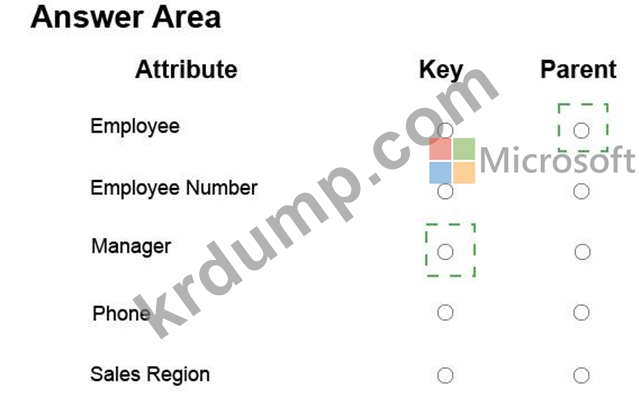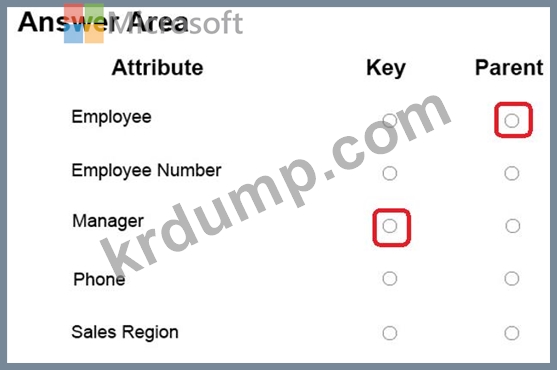70-768 문제 16
Note: This question is part of a series of questions that present the same scenario. Each question in the series contains a unique solution. Determine whether the solution meets the stated goals.
You have an existing multidimensional cube that provides sales analysis. The users can slice by date, product, location, customer, and employee.
The management team plans to evaluate sales employee performance relative to sales targets. You identify the following metrics for employees:
You need to implement the KPI based on the Status expression.
Solution: You design the following solution:

Does the solution meet the goal?
You have an existing multidimensional cube that provides sales analysis. The users can slice by date, product, location, customer, and employee.
The management team plans to evaluate sales employee performance relative to sales targets. You identify the following metrics for employees:
You need to implement the KPI based on the Status expression.
Solution: You design the following solution:

Does the solution meet the goal?
70-768 문제 17
Note: This question is part of a series of questions that present the same scenario. Each question in the series contains a unique solution. Determine whether the solution meets the stated goals.
You deploy a tabular data model to an instance of Microsoft SQL Server Analysis Services
(SSAS). The model uses an in-memory cache to store and query data. The data set is already the same size as the available RAM on the server. Data volumes are likely to continue to increase rapidly.
Your data model contains multiple calculated tables.
The data model must begin processing each day at 2:00 and processing should be complete by 4:00 the same day. You observe that the data processing operation often does not complete before 7:00. This is adversely affecting team members.
You need to improve the performance.
Solution: Change the storage mode for the data model to DirectQuery.
Does the solution meet the goal?
You deploy a tabular data model to an instance of Microsoft SQL Server Analysis Services
(SSAS). The model uses an in-memory cache to store and query data. The data set is already the same size as the available RAM on the server. Data volumes are likely to continue to increase rapidly.
Your data model contains multiple calculated tables.
The data model must begin processing each day at 2:00 and processing should be complete by 4:00 the same day. You observe that the data processing operation often does not complete before 7:00. This is adversely affecting team members.
You need to improve the performance.
Solution: Change the storage mode for the data model to DirectQuery.
Does the solution meet the goal?
70-768 문제 18
HOTSPOT
You have a Microsoft SQL Server Analysis Services (SSAS) multidimensional project. You are developing a dimension that uses data from the following table:

The ManagerKey column defines a foreign key constraint that references the EmployeeKey column. The table stores employee history information by using slowly changing dimensions (SCD). Changes to EmployeeName, Phone, or ManagerKey are managed as
SCD Type 1 changes. Changes to SalesRegion are managed as SCD Type 2 changes.
You create the following attributes, and set the KeyColumns and NameColumn properties to the columns listed in the table below:

You need to add a parent-child hierarchy to the dimension to enable navigating the organization hierarchy.
In the table below, identify the attribute that you must use for each attribute usage type.
NOTE: Make only one selection in each column.

You have a Microsoft SQL Server Analysis Services (SSAS) multidimensional project. You are developing a dimension that uses data from the following table:

The ManagerKey column defines a foreign key constraint that references the EmployeeKey column. The table stores employee history information by using slowly changing dimensions (SCD). Changes to EmployeeName, Phone, or ManagerKey are managed as
SCD Type 1 changes. Changes to SalesRegion are managed as SCD Type 2 changes.
You create the following attributes, and set the KeyColumns and NameColumn properties to the columns listed in the table below:

You need to add a parent-child hierarchy to the dimension to enable navigating the organization hierarchy.
In the table below, identify the attribute that you must use for each attribute usage type.
NOTE: Make only one selection in each column.

70-768 문제 19
You are building a Microsoft SQL Server Analysis Services multidimensional model over a
SQL Server database. In a cube named OrderAnalysis, there is a standard cube dimension named Stock Item.
This dimension has the following attributes:
Users report that the attributes Stock Item Key and Photo are distracting and are not providing any value. They have asked for the attributes to be removed. However, these attributes are needed by other cubes.
You need to hide the specified attributes from the end users of the OrderAnalysis cube.
You do not want to change the structure of the dimension.
Which change should you make to the properties for the Stock Item Key and Photo attributes?
SQL Server database. In a cube named OrderAnalysis, there is a standard cube dimension named Stock Item.
This dimension has the following attributes:
Users report that the attributes Stock Item Key and Photo are distracting and are not providing any value. They have asked for the attributes to be removed. However, these attributes are needed by other cubes.
You need to hide the specified attributes from the end users of the OrderAnalysis cube.
You do not want to change the structure of the dimension.
Which change should you make to the properties for the Stock Item Key and Photo attributes?
70-768 문제 20
Note: This question is part of a series of questions that use the same or similar answer choices. An answer choice may be correct for more than one question in the series. Each question is independent of the other questions in this series. Information and details provided in a question apply only to that question.
You administer a Microsoft SQL Server Analysis Services (SSAS) tabular model for a retail company. The model is the basis for reports on inventory levels, popular products, and regional store performance.
The company recently split up into multiple companies based on product lines. Each company starts with a copy of the database and tabular model that contains data for a specific product line.
You need to optimize performance of queries that use the copied tabular models while minimizing downtime.
What should you do?
You administer a Microsoft SQL Server Analysis Services (SSAS) tabular model for a retail company. The model is the basis for reports on inventory levels, popular products, and regional store performance.
The company recently split up into multiple companies based on product lines. Each company starts with a copy of the database and tabular model that contains data for a specific product line.
You need to optimize performance of queries that use the copied tabular models while minimizing downtime.
What should you do?



